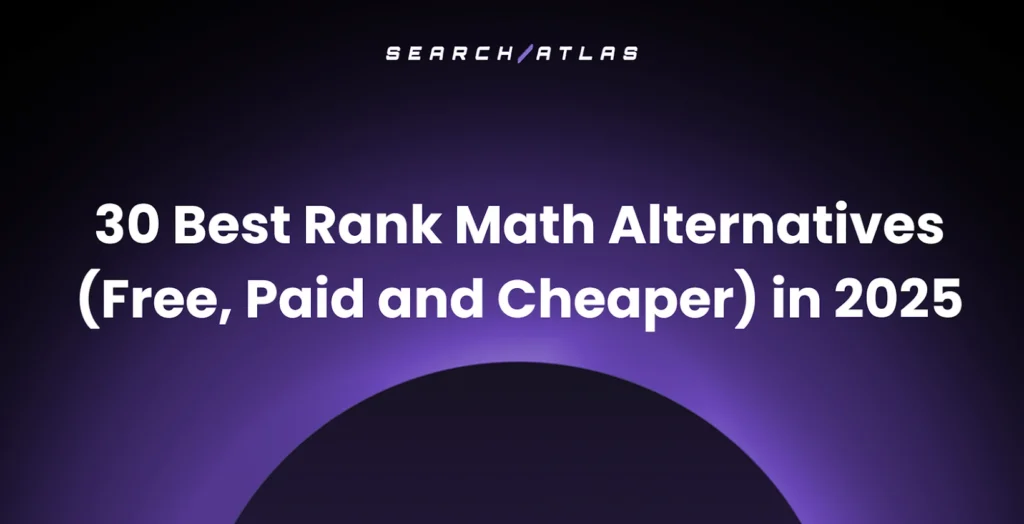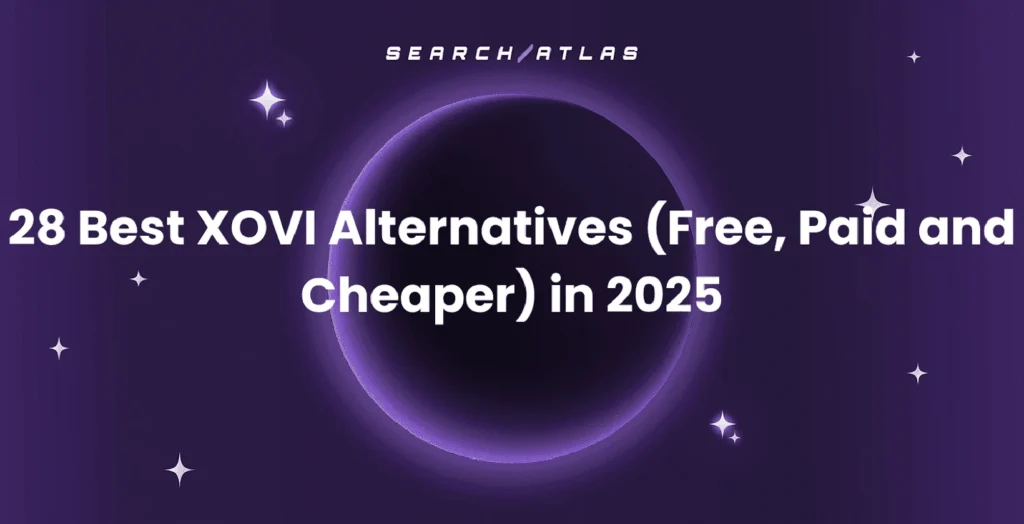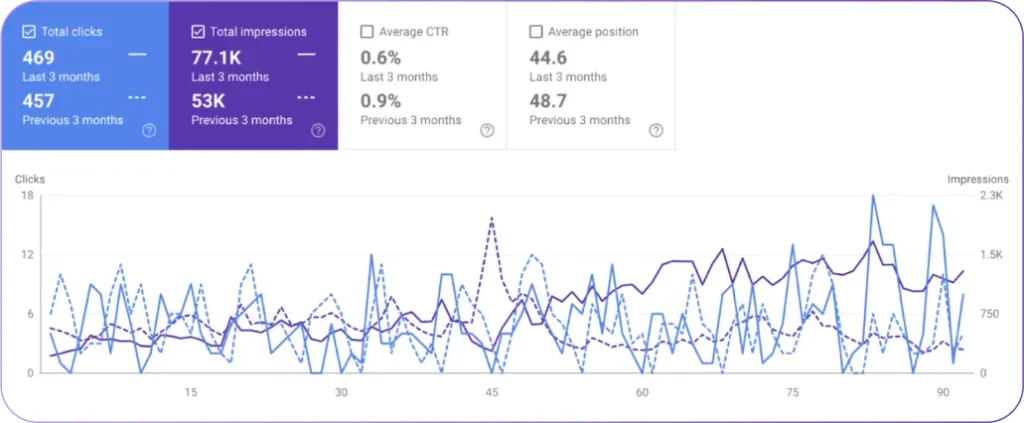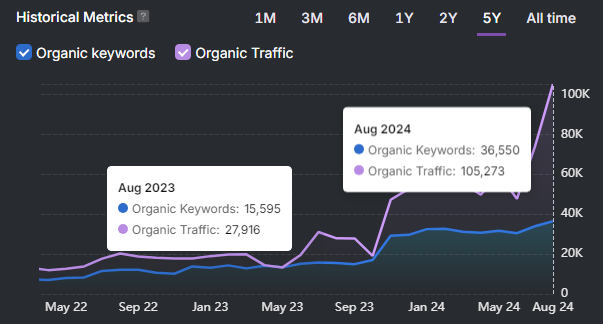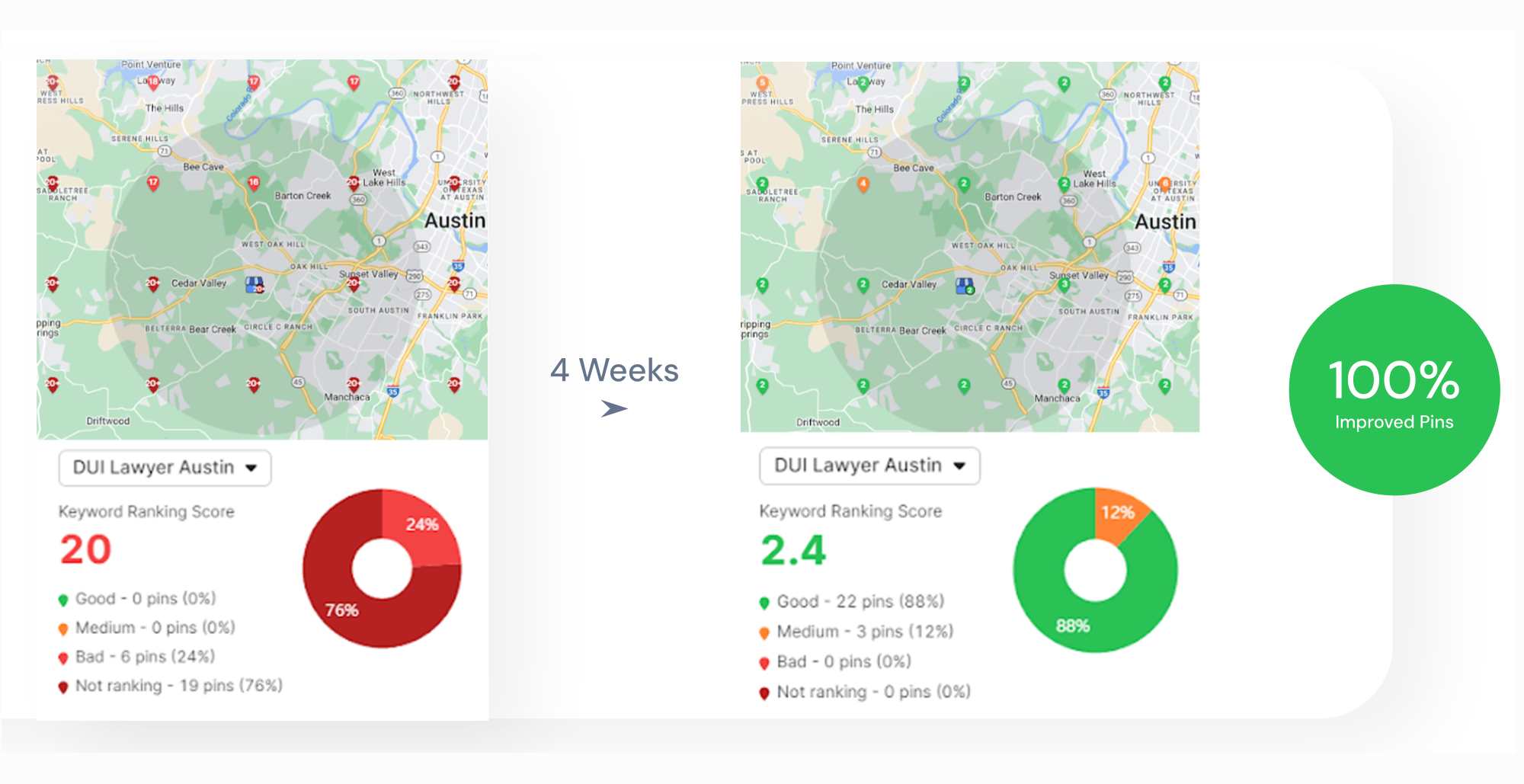Local search visibility drives real business growth, yet the factors behind Google Business Profile (GBP) rankings remain unclear. This study aims to illuminate those drivers.
We analyzed 7,718 businesses across 676 sectors and 18 industries, including Real Estate, Food & Restaurants, Health, Legal, Technology/Creative, Retail, and Professional Services — combining GBP data, reviews, website content, and SERP grid performance to measure ranking outcomes.
The study defines how GBP rankings shift based on proximity, reviews, and relevance. GBP ranking is the process by which Google orders businesses in the local map pack. GBP ranking matters because it determines which businesses users see first and influences foot traffic, calls, and conversions.
The analysis investigates distance to the search centroid (the center point of a search area that Google uses to determine the relevance of nearby businesses for a local query), review volume and keyword relevance, content alignment in business names and websites, and GBP metadata completeness. It provides measurable insights, sector-specific breakdowns, and actionable recommendations. The study matters because local search directly affects customer discovery and business performance.
What is the Final Takeaway?
The study by Search Atlas, authored in August 2025, shows proximity is the strongest overall driver of local Google rankings, while reviews and relevance determine competitive advantage. Proximity sets the baseline for visibility, review signals differentiate businesses, and semantic relevance matters most in sector-specific contexts.
Businesses aiming for local success should focus on keyword-rich, authentic reviews, aligning business names and GBP content with search intent, and maintaining complete, accurate profiles. Sector-specific strategies outperform generic approaches. By adopting evidence-based, vertical-focused tactics, businesses achieve higher predictability and stronger rankings in competitive local search results.
Methodology
The study by Search Atlas uses machine learning to analyze local ranking factors. Machine learning (ML) means training models on data to uncover patterns. ML produces feature importance scores. ML matters because it shows which signals actually influence Google Business Profile rankings.
The researchers used XGBoost regression, a type of ML algorithm. XGBoost handles large, complex datasets, ranks features by importance, and works well with structured business and search data. XGBoost matters because it predicts rankings accurately and highlights the strongest drivers of visibility.
The dataset combines several key sources:
- Keyword-based SERP grid data: Tracks business positions across search results.
- Business profile metadata: Includes names, categories, ratings, review counts, and profile completeness.
- Website content and backlinks: Measures domain authority and relevance.
- Customer reviews: Text analysis checks if reviews match search queries.
- Extra metrics: Ads and search console data where available.
The target variable is average GBP position, the mean rank of a business across SERP queries. Average position matters because it measures local search visibility and shows which businesses appear higher in results.
What Does the Global Analysis Show?
According to the global analysis conducted by Search Atlas, the model explains 92% to 93% of the variance in GBP rankings. The global model uses the all-sectors dataset, weighting features across industries. Key factors vary depending on the ranking positions.
The key factors that influence business ranks in local search results for positions 1 to 21 are listed below:
- Proximity (55.2%): Distance to the search centroid dominates, making location the strongest driver of visibility.
- Review Count (19.2%): The volume of reviews strongly boosts rankings.
- Domain Power (5.9%): Website authority has a moderate but noticeable impact.
- Semantic Relevance in Reviews (5.3%): Content alignment in customer reviews helps improve rank.
- Other Factors (<5%): Category relevance, ratings, GBP completeness, and backlinks contribute smaller but meaningful influence.
The key factors that influence business ranks in local search results for positions 1 to 10 are listed below.
- Proximity (36.2%): Still the leading factor, but less dominant at the very top.
- Review Count (26%): Plays a bigger role among top-ranked businesses.
- Review Keyword Relevance (22.8%): Semantic content in reviews becomes crucial for breaking into the top 10.
- Supporting Features: Ratings, domain power, and GBP completeness provide secondary lift.
Proximity, review signals, and semantic alignment are the strongest drivers of Google local rankings, while profile details, ratings, and backlinks play only minor roles.
What are the Sector-Based Findings?
I, Manick Bhan, along with David Conde and Euthymios Kasvikis, ran experiments across major sectors to show which factors matter most for rankings in each industry. The breakdown to show which factors matter most for rankings in each industry is listed below.
Accounting & Finance Sector
The Accounting & Finance sector is driven by proximity, reviews, and domain authority. This category includes accountants, tax advisors, and financial consultants. Ranking in this sector depends on credibility and local accessibility.
The rankings for financial service businesses and the main influencing factors are shown below.
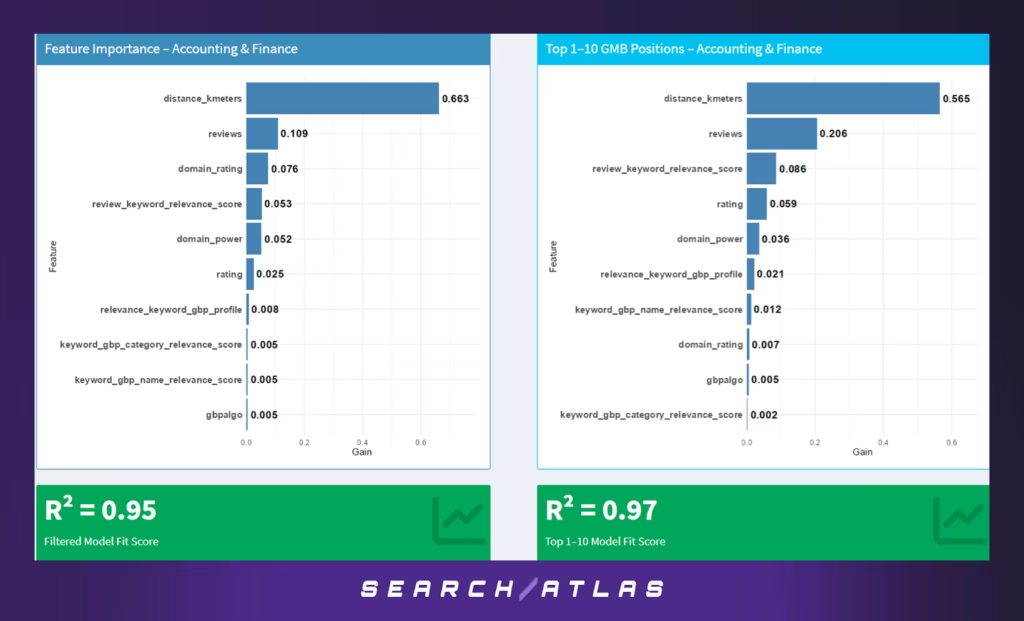
All positions: The model explained 95% of ranking differences. Distance is the dominant factor (66%), followed by reviews (10.9%) and domain power (~5%). Review keyword relevance adds moderate influence (5.3%), confirming that trust and authority shape visibility.
Positions 1 to 10: The model explained 97% of ranking differences. Distance remains key (56.5%), but reviews (20.6%) and review keyword relevance (8.6%) grow in weight. Rating and authority metrics gain minor importance.
Accounting and finance businesses must prioritize location accuracy and review generation while maintaining strong online authority to climb in the top 10.
Automotive Sector
The Automotive sector heavily relies on proximity and reputation signals. It covers auto repair, tire, and mechanic services, where immediacy and trust drive local rankings.
The rankings for automotive businesses and the main influencing factors are shown below.
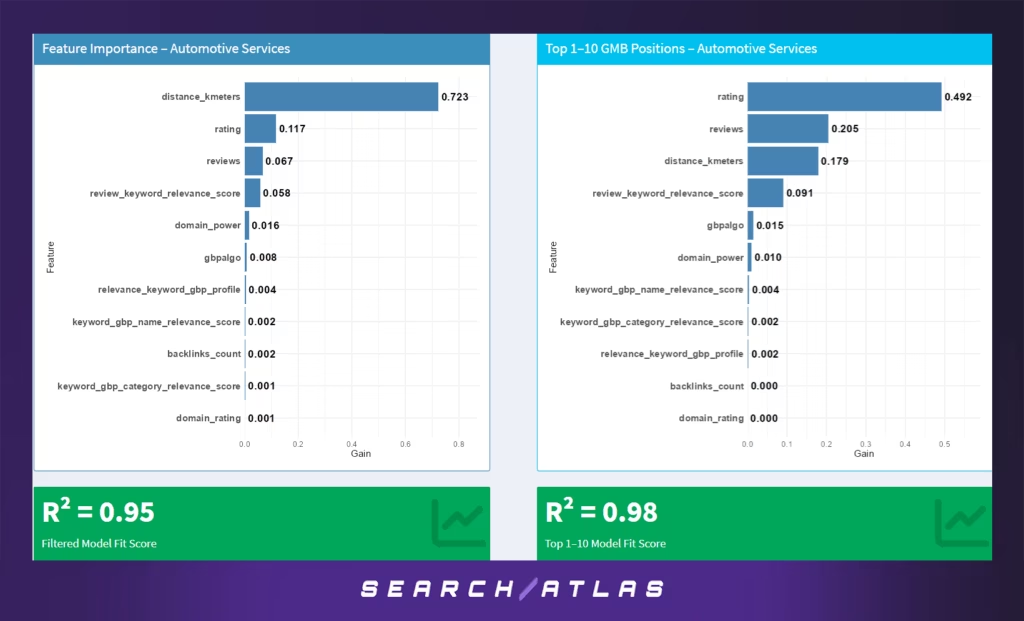
All positions: The model explained 95% of ranking differences. Distance dominates (72.3%), while rating (11.7%) and reviews (6.7%) show measurable influence. Review keyword relevance (5.8%) provides minor gains.
Positions 1 to 10: The model explained 98% of ranking differences. Rating becomes the top factor (49.2%), followed by reviews (20.5%) and review keyword relevance (9.1%). Distance drops to 17.9%.
Automotive businesses must focus on high ratings and detailed reviews once proximity is achieved, as sentiment and review quality determine top placement.
Construction Sector
The Construction sector blends trust and proximity, with customer validation being key. It includes contractors, builders, roofers, and renovation specialists. Rankings hinge on review activity and service visibility.
The rankings for construction businesses and the main influencing factors are shown below.
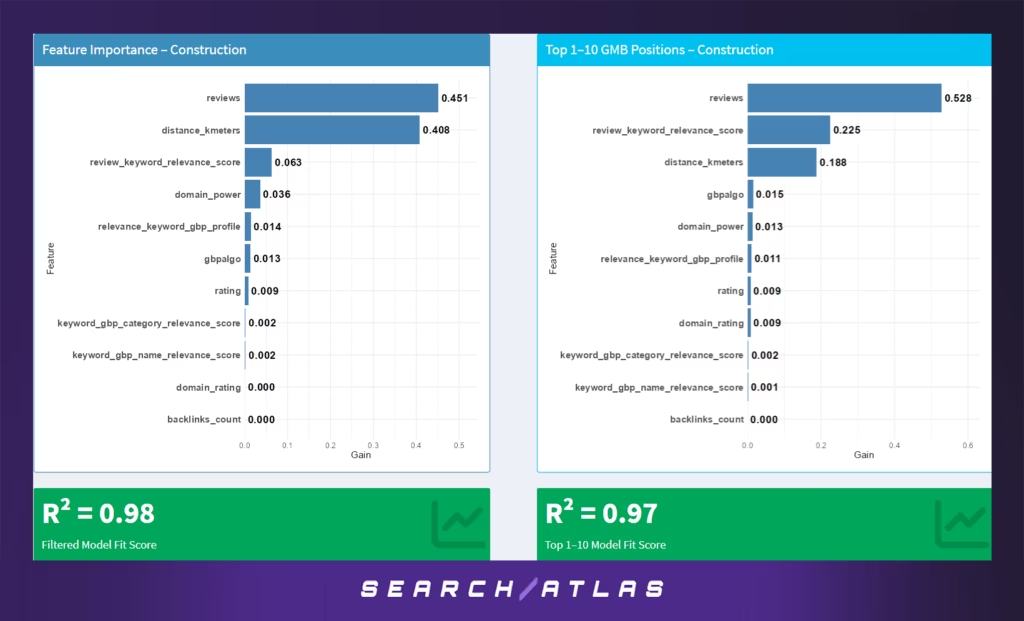
All positions: The model explained 98% of ranking differences. Review count (45.1%) and proximity (40.8%) drive most visibility, with review keyword relevance (6.3%) and domain power (3.6%) adding minor gains.
Positions 1 to 10: The model explained 98% of ranking differences. Review volume dominates (52.8%), followed by review keyword relevance (22.5%) and proximity (18.8%).
Construction businesses must maximize review quantity and keyword-rich customer feedback. Once local presence is established, reputation and semantic alignment become decisive.
Education Sector
The Education sector emphasizes proximity, relevance, and credibility. It includes tutoring centers, schools, and language institutes. Ranking in this field reflects trust and local engagement.
The rankings for educational businesses and the main influencing factors are shown below.
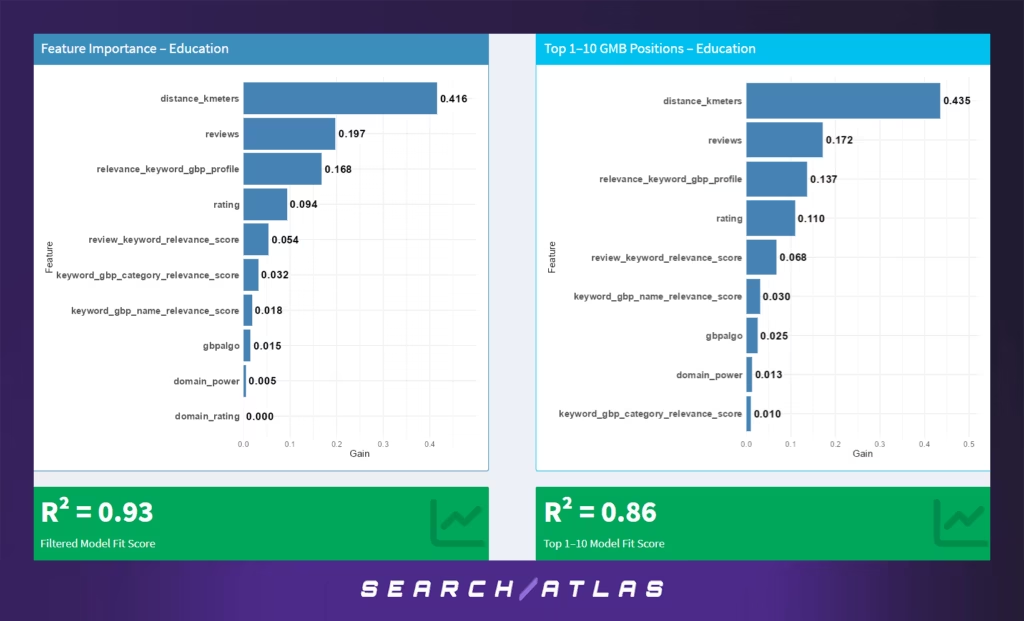
All positions: The model explained 93% of ranking differences. Distance is most influential (41.6%), followed by reviews (19.7%) and profile-keyword relevance (16.8%). Rating (9.4%) and review keyword relevance (5.4%) contribute smaller roles.
Positions 1 to 10: The model explained 86% of ranking differences. Distance rises (43.5%), with reviews (17.2%), rating (11%), and profile-keyword relevance (13.7%) maintaining significance.
Education providers should focus on accurate location data, consistent reviews, and keyword-aligned GBP profiles to strengthen both visibility and credibility.
Events & Entertainment Sector
The Events & Entertainment sector depends on proximity, reviews, and GBP keyword alignment. It includes music venues, theaters, escape rooms, and attractions. Rankings rely on both local relevance and public sentiment.
The rankings for entertainment businesses and the main factors influencing them are shown below.
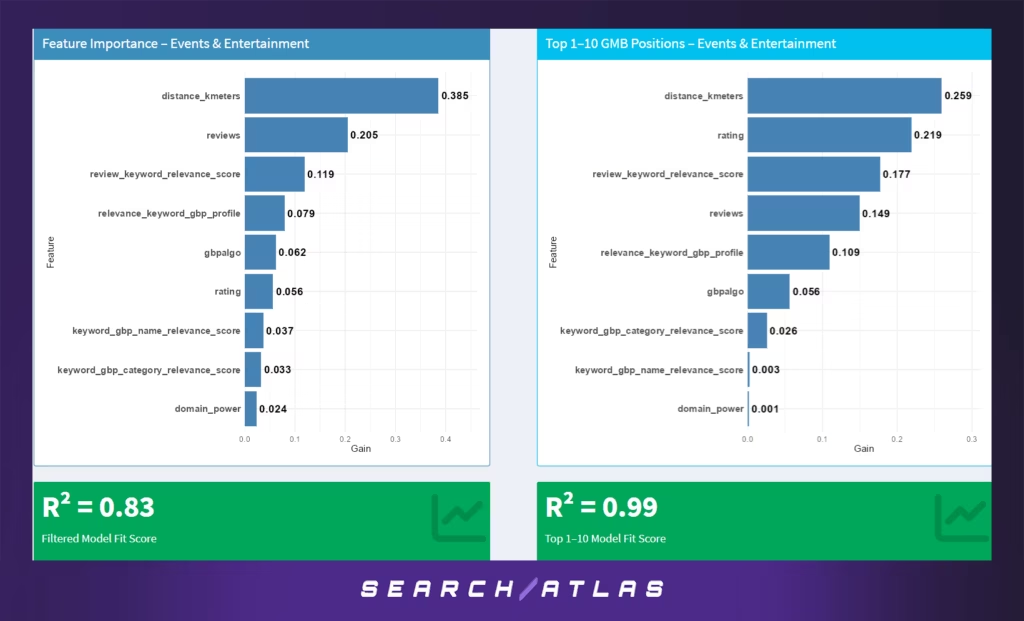
All positions: The model explained 83% of ranking differences. Distance is the strongest factor (38.5%), followed by reviews (20.5%) and review keyword relevance (11.9%). GBP profile relevance (7.9%) and Google’s algorithm score (6.2%) also contribute meaningfully.
Positions 1 to 10: The model explained 99% of ranking differences. Rating rises sharply (21.9%), while distance drops (25.9%). Review keyword relevance (17.7%) and review volume (14.9%) remain key differentiators. GBP profile relevance (10.9%) supports top-tier performance.
Entertainment businesses must balance proximity with reputation—encouraging keyword-rich, sentiment-driven reviews and optimizing profile content for topical alignment.
Food & Restaurants Sector
The Food & Restaurants sector values proximity, review content, and GBP optimization. It includes cafes, quick-service chains, and fine dining. Visibility depends on local reach, relevance, and reputation.
The rankings for food businesses and the main factors influencing them are shown below.
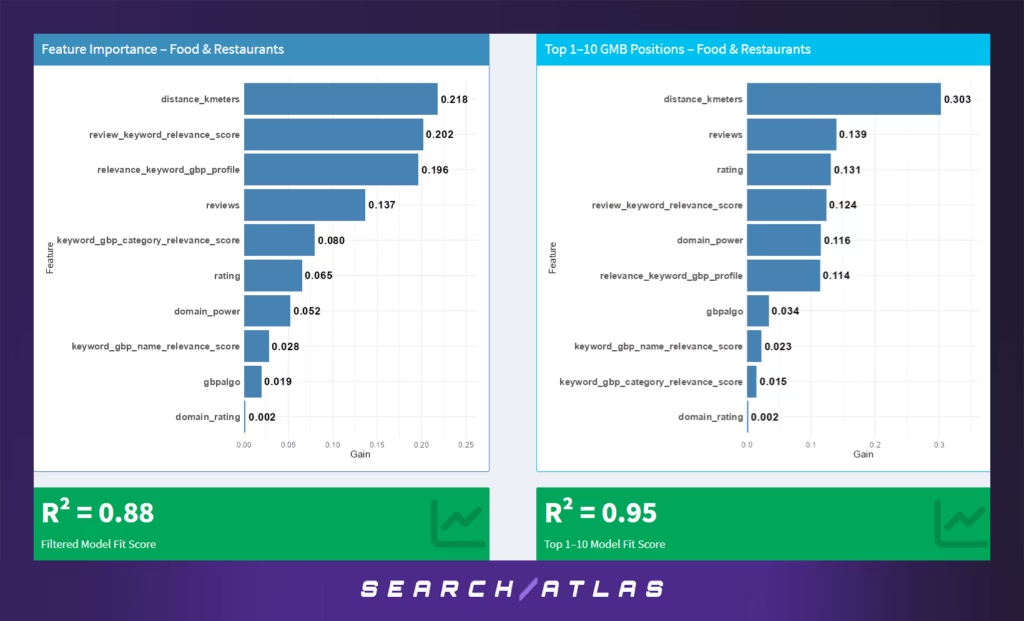
All positions: The model explained 88% of ranking differences. Proximity (21.8%) plays a role, but review keyword relevance (20.2%) and GBP profile relevance (19.6%) are nearly as strong. Reviews (13.7%) and category relevance (8.0%) add weight, while ratings (6.5%) and domain power (5.2%) provide secondary support.
Positions 1 to 10: The model explained 95% of ranking differences. Distance becomes dominant (30.3%), while reviews (13.9%), rating (13.1%), and review keyword relevance (12.4%) stay influential. Domain power (11.6%) and GBP relevance (11.4%) strengthen among high performers.
Restaurants should focus on review management, keyword-rich feedback, and GBP completeness to maintain visibility in competitive local searches.
Handyman Services Sector
The Handyman Services sector is driven by proximity, review quantity, and review relevance. It includes local professionals offering repair, maintenance, and home services. Rankings depend on visibility, trust, and immediate availability.
The rankings for handyman businesses and the main factors influencing them are shown below.
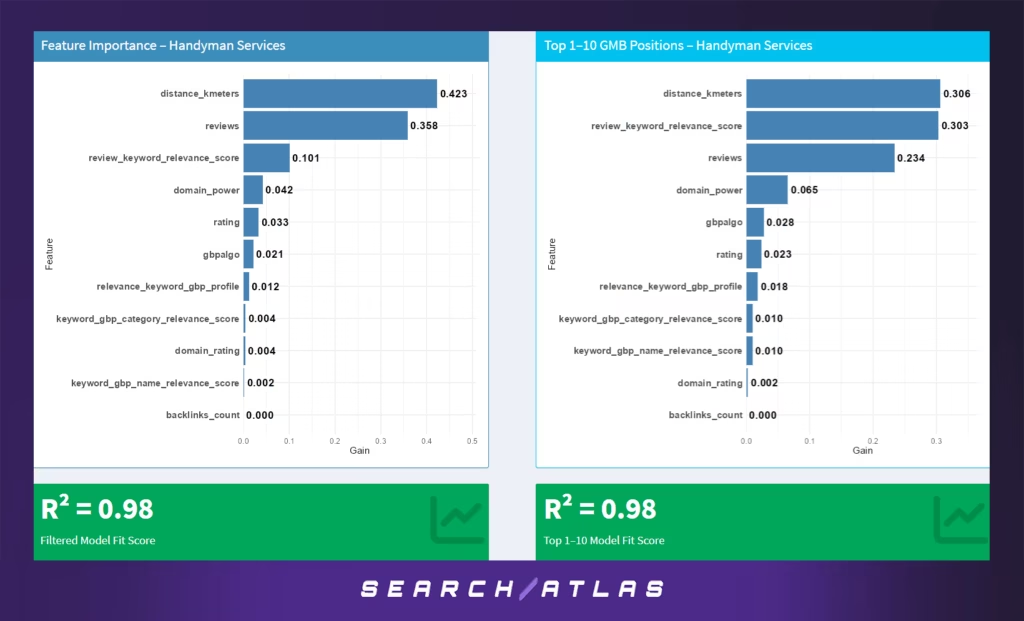
All positions: The model explained 98% of ranking differences. Distance (42.3%) and reviews (35.8%) dominate, while review keyword relevance (10.1%) enhances visibility. Domain power (4.2%) and ratings (3.3%) contribute minor influence.
Positions 1 to 10: The model explained 98% of ranking differences. Distance (30.6%) and review keyword relevance (30.3%) share top importance. Review volume (23.4%) remains critical, with small boosts from domain power (6.5%) and rating (2.3%).
Handyman businesses must cultivate detailed, service-specific reviews and maintain proximity-based coverage to maximize rankings.
Healthcare Sector
The Healthcare sector relies on reviews, proximity, and authority. It covers clinics, medical practices, and urgent care providers. Visibility depends on trust, compliance, and accessibility.
The rankings for healthcare businesses and the main factors influencing them are shown below.
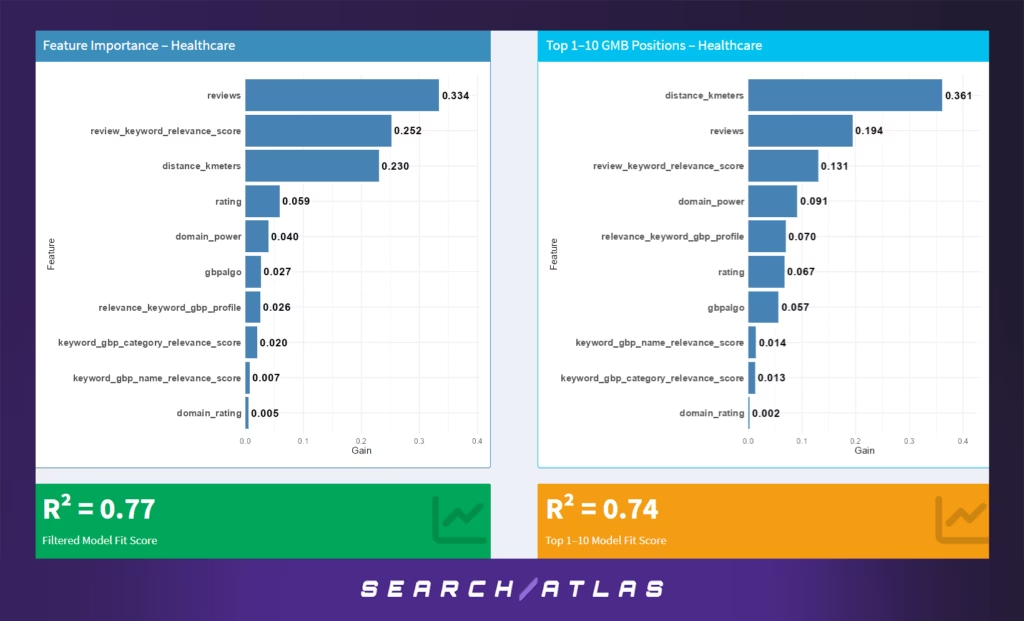
All positions: The model explained 77% of ranking differences. Reviews (33.4%) and review keyword relevance (25.2%) lead, with proximity (23.0%) close behind. Domain power (4.0%) and rating (5.9%) have a minor influence.
Positions 1 to 10: The model explained 74% of ranking differences. Proximity increases (36.1%), while reviews (19.4%) and keyword relevance (13.1%) remain key. Domain power (9.1%) and GBP keyword relevance (7.0%) gain significance.
Healthcare providers should emphasize compliant review collection, mobile-local optimization, and clear service alignment within GBP profiles.
Hospitality & Travel Sector
The Hospitality & Travel sector emphasizes proximity, reputation, and GBP optimization. It includes hotels, resorts, and tour operators. Rankings depend on trust, authority, and content relevance.
The rankings for hospitality businesses and the main factors influencing them are shown below.
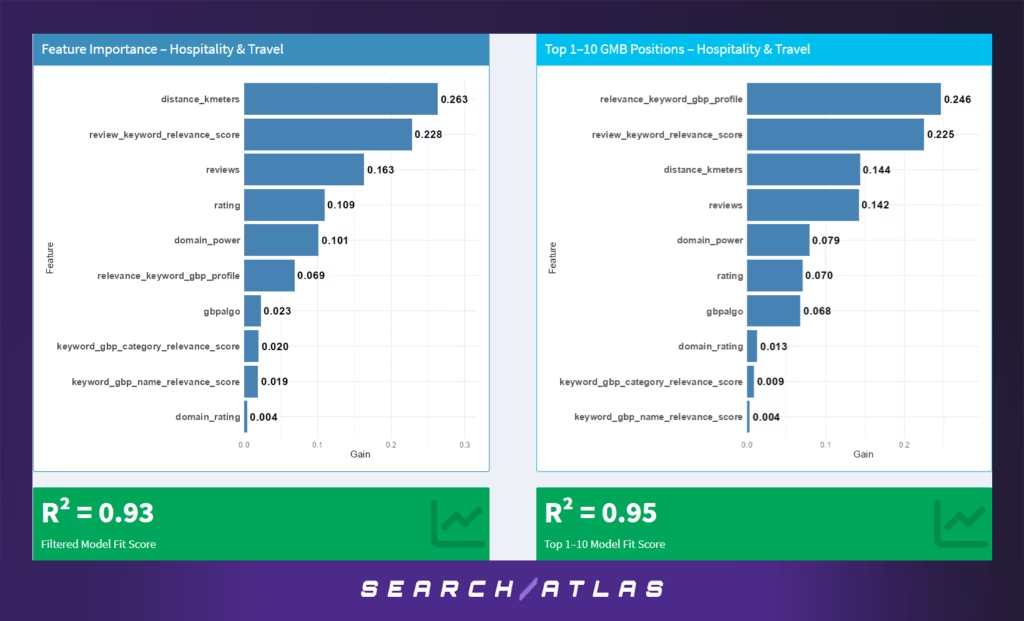
All positions: The model explained 93% of ranking differences. Distance (26.3%) leads, followed by review keyword relevance (22.8%) and review volume (16.3%). Rating (10.9%) and domain power (10.1%) also carry strong weight.
Positions 1 to 10: The model explained 95% of ranking differences. GBP profile keyword relevance rises to the top (24.6%), followed by review keyword relevance (22.5%). Proximity (14.4%) and review volume (14.2%) remain influential.
Hospitality brands should refine GBP descriptions, encourage keyword-rich guest reviews, and leverage domain authority to build visibility and credibility.
Legal Services Sector
The Legal Services sector is the most proximity-dependent among all industries analyzed. Because law firms serve local jurisdictions, rankings are dominated by physical location.
The rankings for legal businesses and the main factors influencing them are shown below.
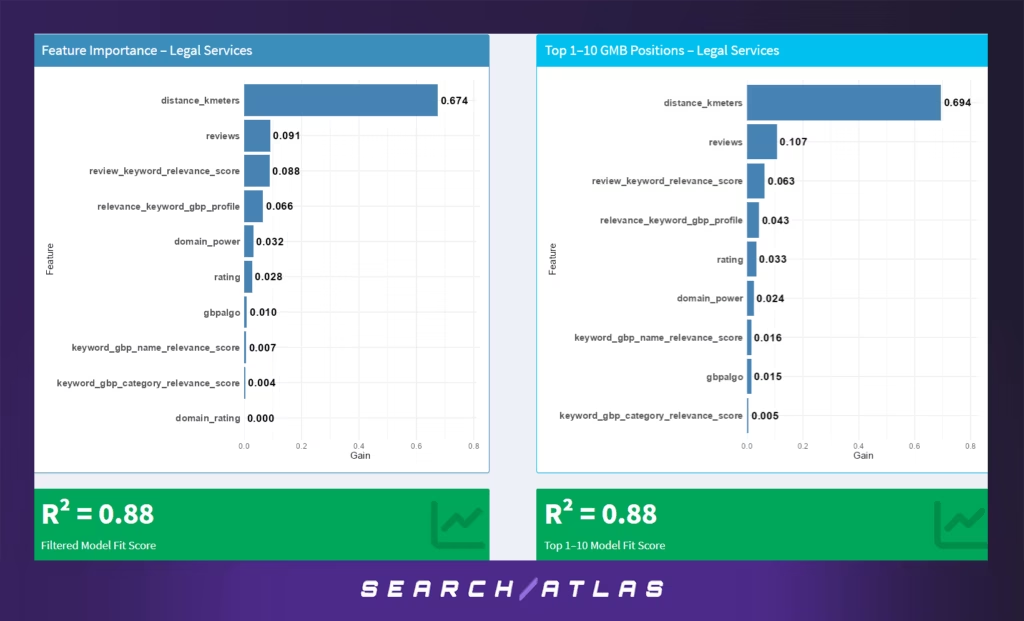
All positions: The model explains 88% of ranking variance. Distance to centroid is overwhelmingly dominant (67.4%), followed by review volume (9.1%) and review-keyword relevance (8.8%). GBP profile relevance (6.6%) and domain authority (3.2%) add minor influence.
Positions 1 to 10: Distance grows even stronger (69.4%), while reviews (10.7%) and review-keyword relevance (6.3%) remain supportive. Domain and rating factors remain low-impact.
Legal firms rank mainly by proximity, with reviews and keyworded feedback providing secondary differentiation. Location precision and trust-driven reviews are critical.
Logistics Sector
The Logistics sector balances local presence with web authority. As multi-regional operators, logistics providers benefit from both strong GBP activity and domain-level credibility.
The rankings for logistics businesses and the main factors influencing them are shown below.
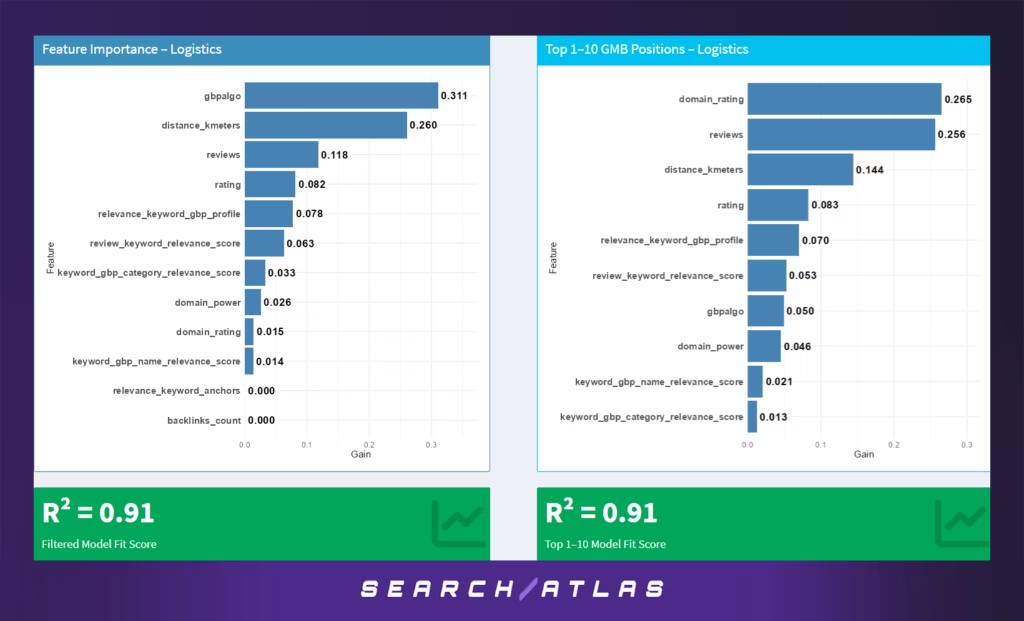
All positions: The model (R² = 0.91) shows Google’s internal GBP engagement score (31.1%) and proximity (26%) as top drivers. Review count (11.8%) and rating (8.2%) also weigh heavily. Keyword relevance factors range between 7.8%–3.3%, with modest domain influence.
Positions 1 to 10: Domain rating leads (26.5%), followed by review count (25.6%) and proximity (14.4%). Rating (8.3%) and profile relevance (7.0%) support rankings.
Top logistics performers succeed through a mix of trust, engagement, and authority, combining strong domains, consistent reviews, and local accuracy.
Manufacturing Sector
The Manufacturing sector blends proximity with reputation-based signals, showing that even B2B businesses depend on local discoverability.
The rankings for manufacturing businesses and the main factors influencing them are shown below.
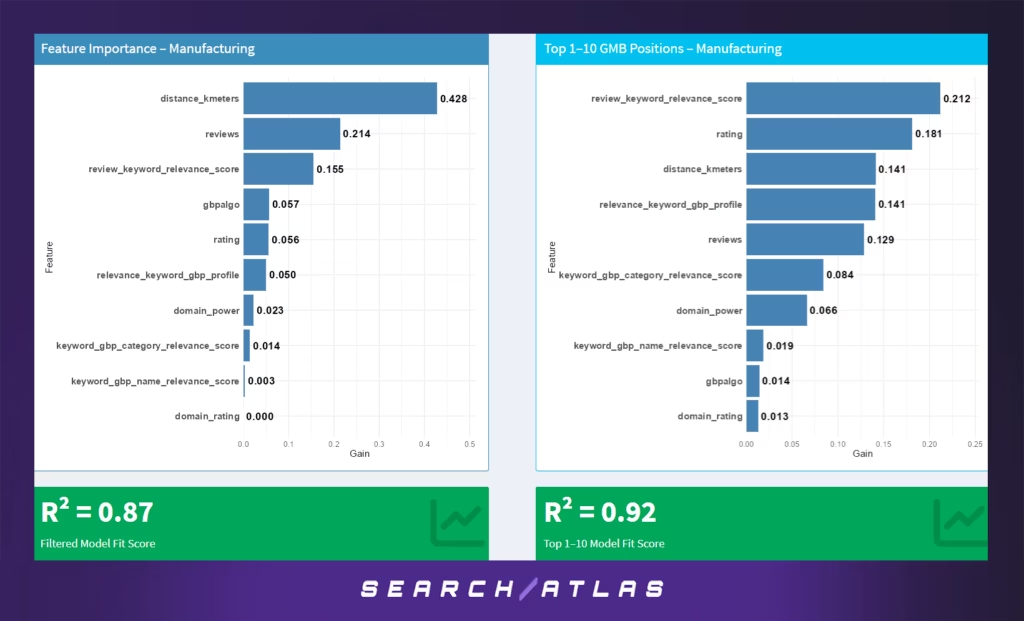
All positions: Proximity dominates (42.8%), with reviews (21.4%) and review-keyword relevance (15.5%) close behind. Google engagement (5.7%) and rating (5.6%) contribute moderately.
Positions 1 to 10: Review-keyword relevance rises to 21.2%, followed by rating (18.1%) and proximity (14.1%). Profile relevance (14.1%) and review count (12.9%) gain importance.
Manufacturers ranking best balance proximity, precise profile descriptions, and keyword-rich reviews that reflect real buyer feedback.
Personal Care Services Sector
Personal Care businesses (salons, spas, wellness providers) rely on proximity and customer sentiment. Visibility is built on convenience and reputation.
The rankings for personal care businesses and the main factors influencing them are shown below.
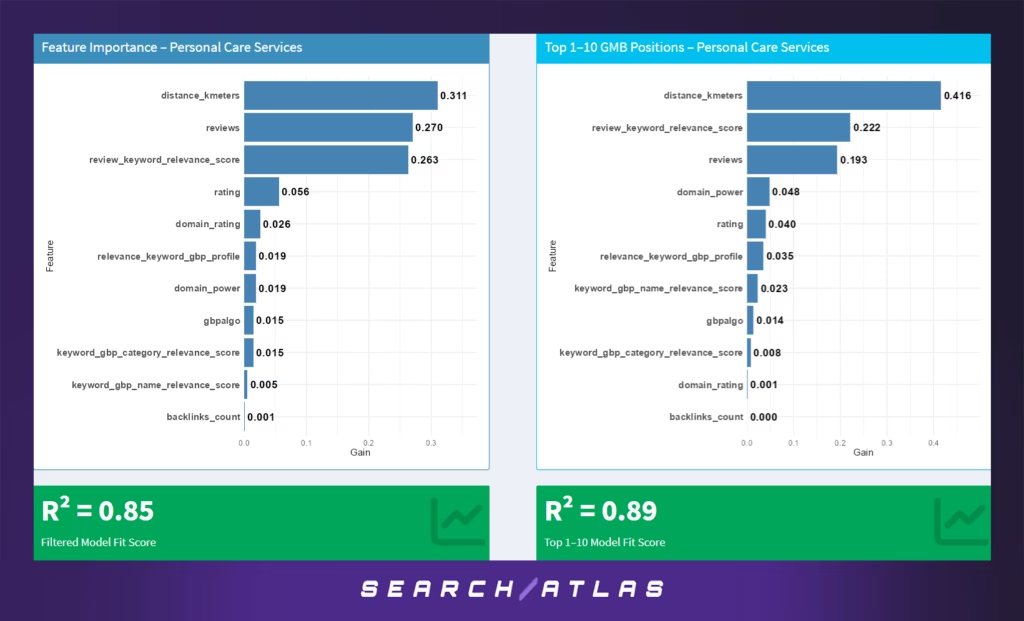
All positions: Proximity (31.1%), review volume (27.0%), and review-keyword relevance (26.3%) dominate. Ratings (5.6%) and SEO signals (<3%) play small roles.
Positions 1 to 10: Distance becomes stronger (41.6%), while review relevance (22.2%) and review volume (19.3%) remain highly influential.
Top results go to providers who are close, reviewed often, and described with relevant service terms in feedback, making this a pure local-reputation model.
Points of Interest (POI) Ranking Factors
Points of Interest (local landmarks, attractions, parks) depend almost entirely on geography and user ratings rather than SEO. Visibility reflects public popularity and location accuracy.
The rankings for the POI sector and the main factors influencing them are shown below.
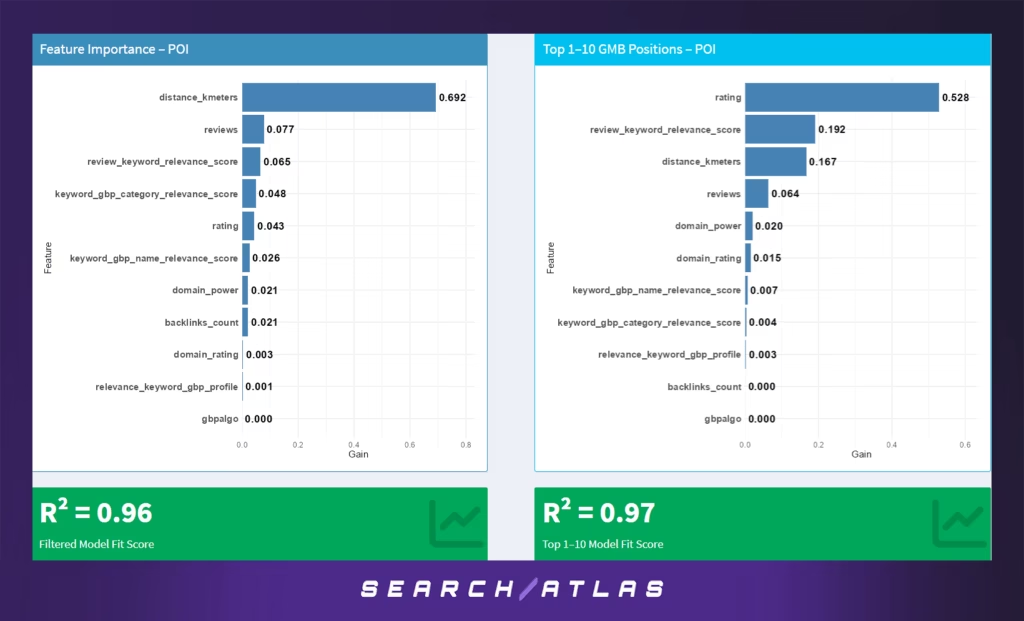
All positions: Distance dominates (69.2%), followed by review volume (7.7%) and review-keyword relevance (6.5%). Category relevance (4.8%) and rating (4.3%) are minor.
Positions 1 to 10: Rating surges as the top factor (52.8%), with review-keyword relevance (19.2%) and distance (16.7%) behind.
For POIs, proximity earns visibility, but excellent ratings and descriptive reviews decide who ranks first.
Professional Services Sector
Professional Services rankings balance proximity, social proof, and semantic optimization, reflecting how clients choose trusted experts (accountants, consultants, architects)
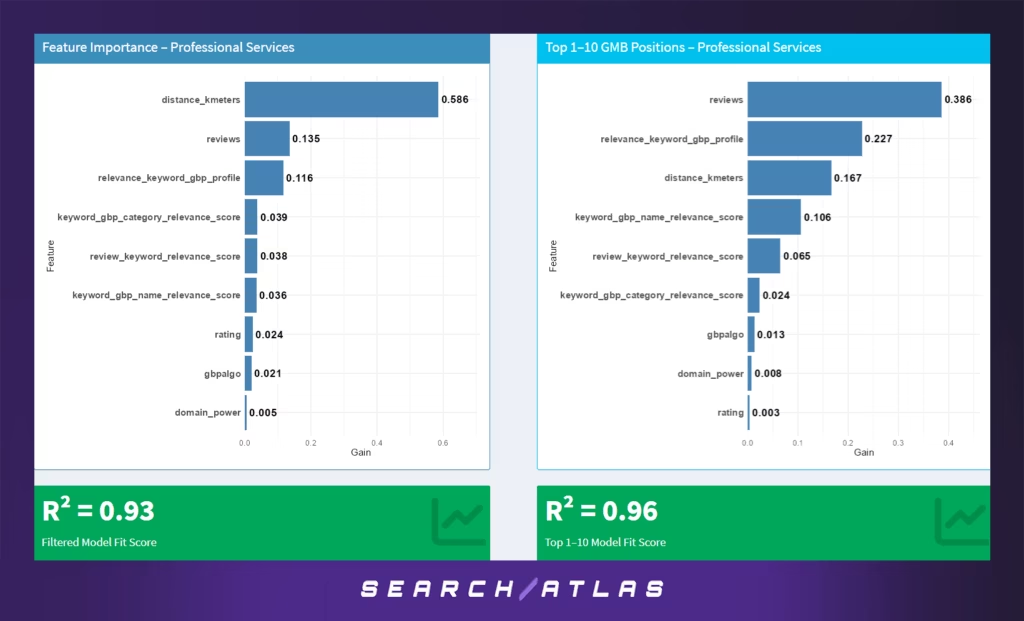
All positions: Distance leads (58.6%), followed by review volume (13.5%) and profile-keyword relevance (11.6%). Category relevance (3.9%), review-keyword relevance (3.8%), and name relevance (3.6%) add smaller boosts. Model fit: R² = 0.93.
Positions 1 to 10: Review volume dominates (38.6%), with profile-keyword relevance (22.7%) and distance (16.7%) close behind. Name relevance (10.6%) and review-keyword alignment (6.5%) further refine top results. Model fit: R² = 0.96.
In Professional Services, proximity earns visibility. However, the primary ranking factors are review quantity and semantic optimization, particularly in GBP content and client feedback.
Real Estate Sector
Real Estate visibility is both proximity- and review-driven, reflecting buyers’ location-specific intent.
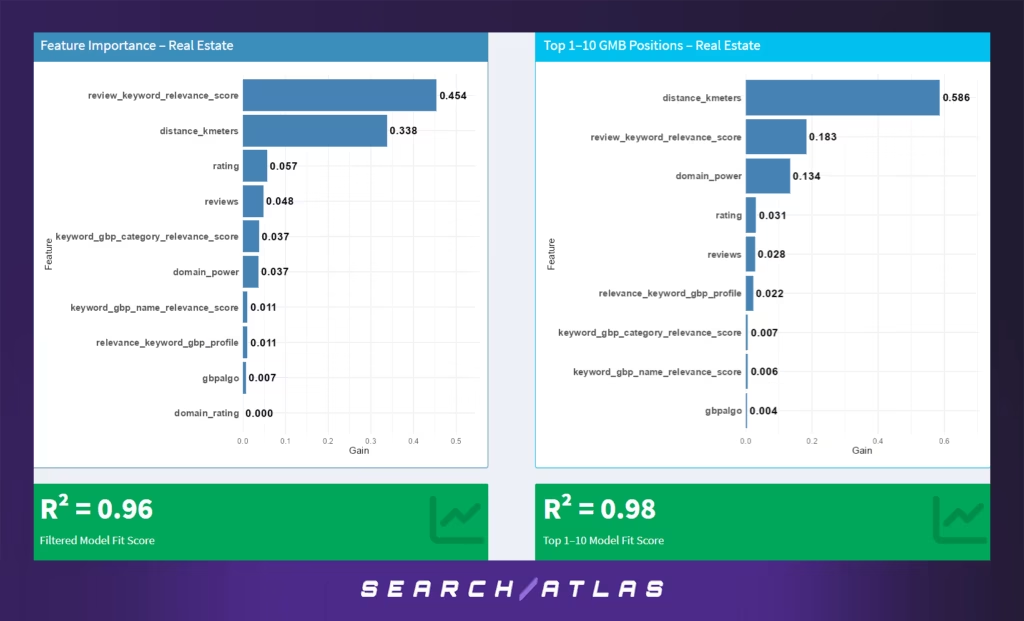
All positions: Review-keyword relevance dominates (45.4%), with distance close behind (33.8%). Ratings (5.7%), review count (4.8%), category relevance (3.7%), and domain power (3.7%) contribute modestly. Model fit: R² = 0.96.
Positions 1 to 10: Distance takes over (58.6%), followed by review-keyword relevance (18.3%) and domain power (13.4%). Ratings (3.1%) and review count (2.8%) have minimal effect.
In Real Estate, proximity earns visibility, but reviews rich in property and neighborhood terms determine who ranks first.
Retail Sector
Retail visibility blends physical proximity with moderate digital influence, driven by shoppers’ location-based intent.
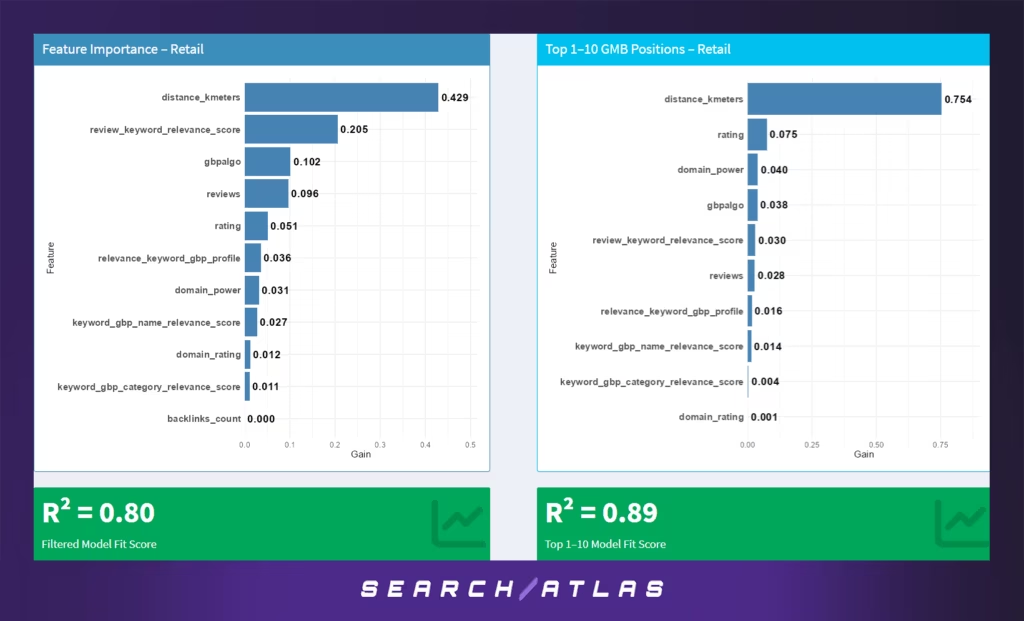
All positions: Distance dominates (42.9%), followed by review-keyword relevance (20.5%), gbpalgo score (10.2%), and review volume (9.6%). Rating (5.1%), profile relevance (3.6%), domain power (3.1%), and name relevance (2.7%) add limited value.
Positions 1 to 10: Distance becomes overwhelming (75.4%), with rating (7.5%), domain power (4.0%), gbpalgo (3.8%), review-keyword relevance (3.0%), and review count (2.8%) contributing marginally.
For retailers, location accuracy decides visibility, while ratings and keyword-rich reviews help sustain top rankings.
Technology / Creative Sector
Technology and Creative Services rankings emphasize semantic relevance and brand credibility over strict proximity, reflecting how clients choose agencies, developers, and designers based on expertise and trust.
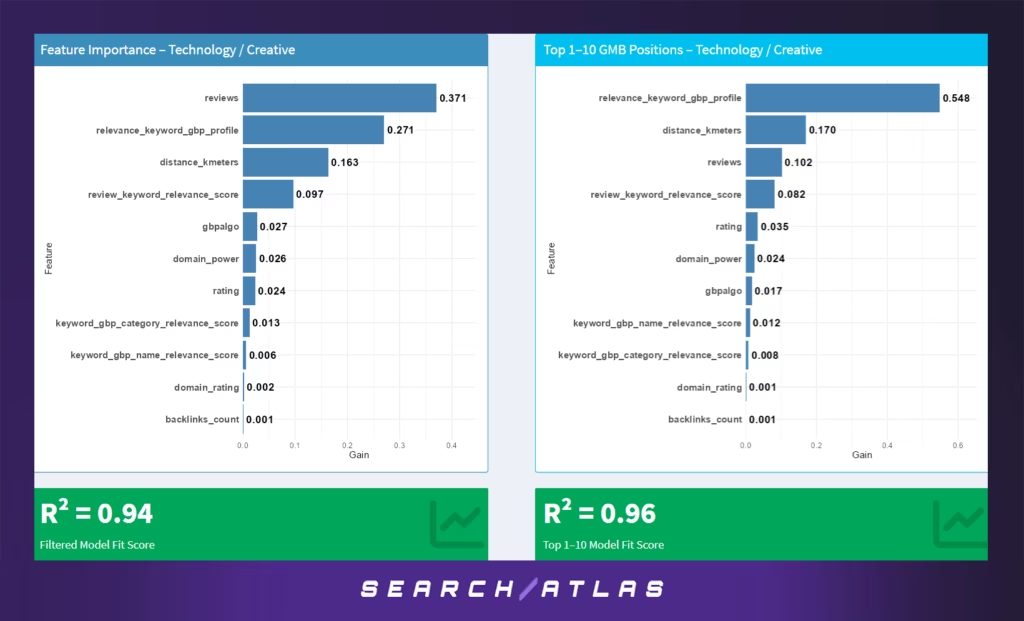
All positions: Reviews lead (37.1%), followed by GBP profile-keyword relevance (27.1%) and proximity (16.3%). Review-keyword relevance adds (9.7%), while gbpalgo (2.7%), domain power (2.6%), and rating (2.4%) have minor effects. Model fit: R² = 0.94.
Positions 1 to 10: Profile relevance dominates (54.8%), with proximity (17.0%) and reviews (10.2%) next. Review-keyword relevance (8.2%) provides additional lift, while rating (3.5%) and domain power (2.4%) contribute slightly. Model fit: R² = 0.96.
In the Technology and Creative industries, semantic relevance drives rankings, reviews build credibility, and proximity plays a secondary role, making precise GBP optimization the key to local visibility.
What Patterns Appear Across Sectors?
Proximity is the strongest driver of local visibility, especially in Legal Services, Retail, and Personal Care, accounting for up to 70% of predictive power.
Top-pack positions (1–10) show more variation: in Technology and Professional Services, semantic relevance between GBP content and queries often outweighs distance. Reviews—both volume and keyword alignment—consistently boost visibility across sectors, sometimes surpassing traditional SEO signals like domain authority or backlinks.
These patterns highlight the need for sector-specific strategies: proximity dominates location-based industries, while content relevance and reviews drive results in knowledge- or service-based sectors.
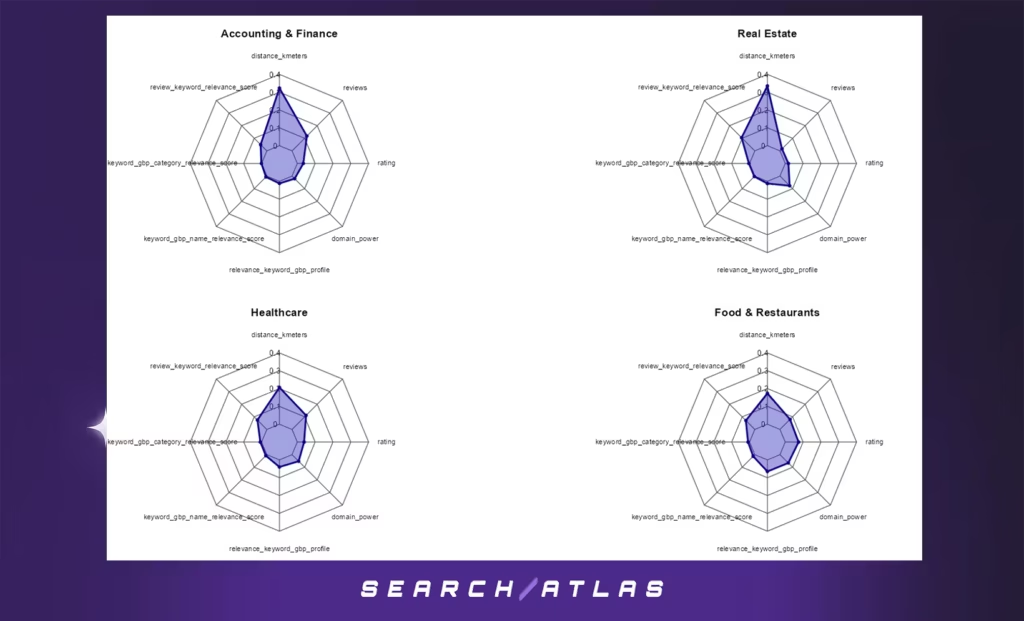
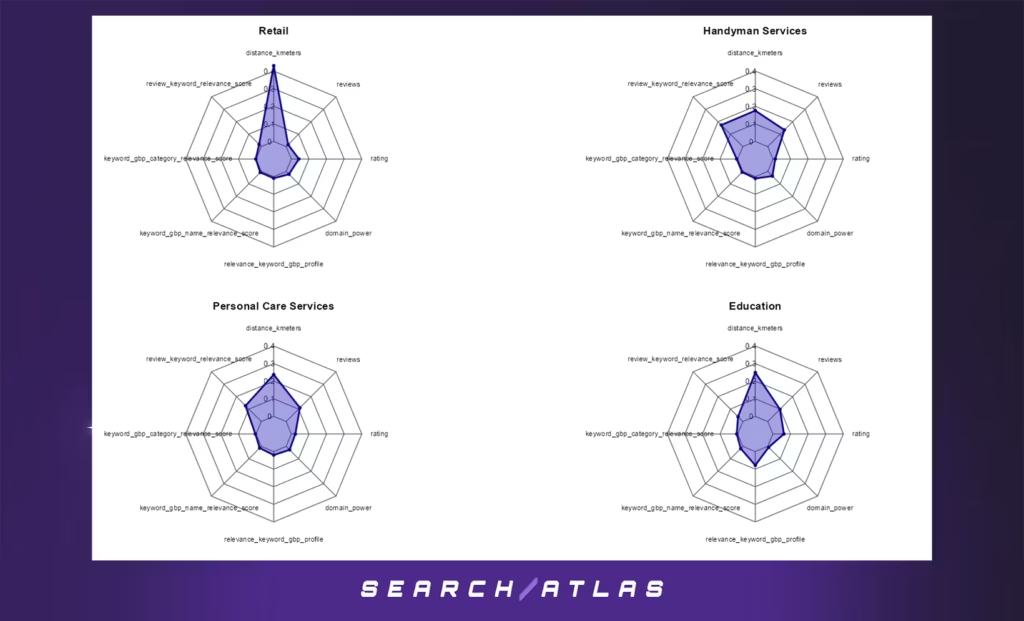
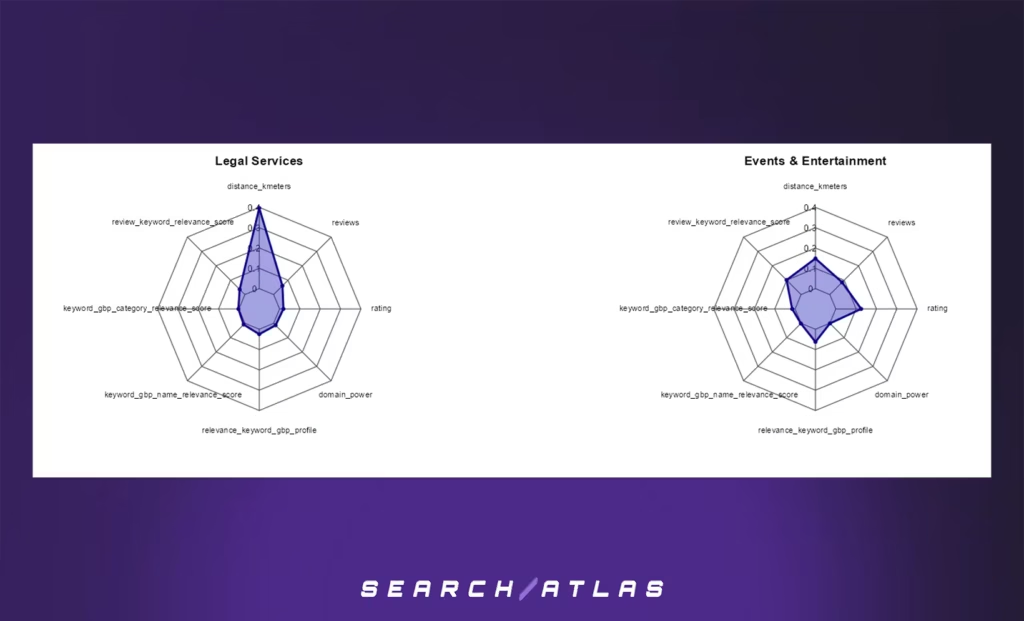
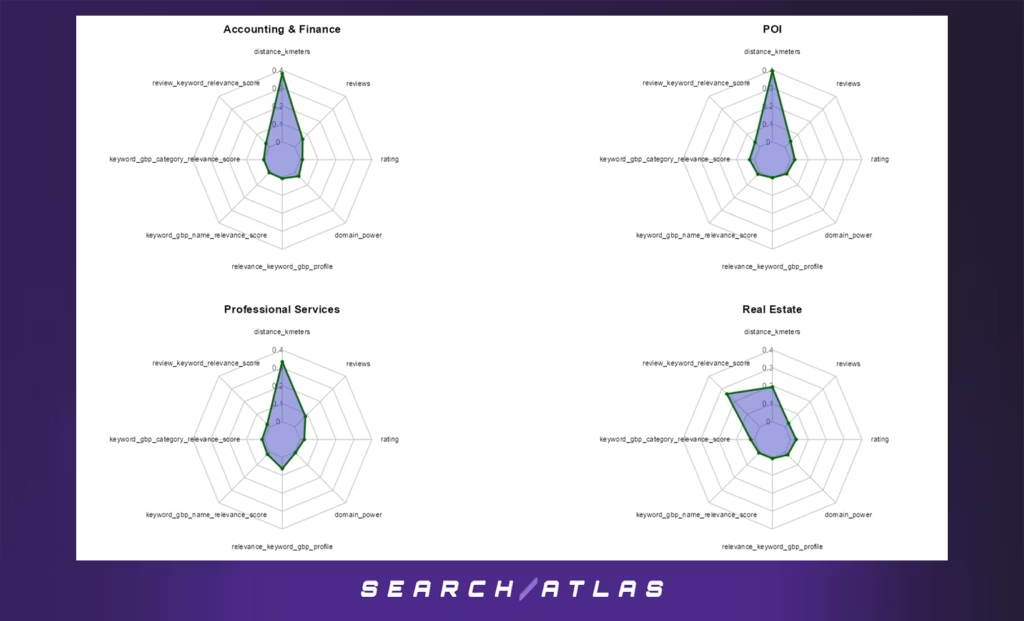
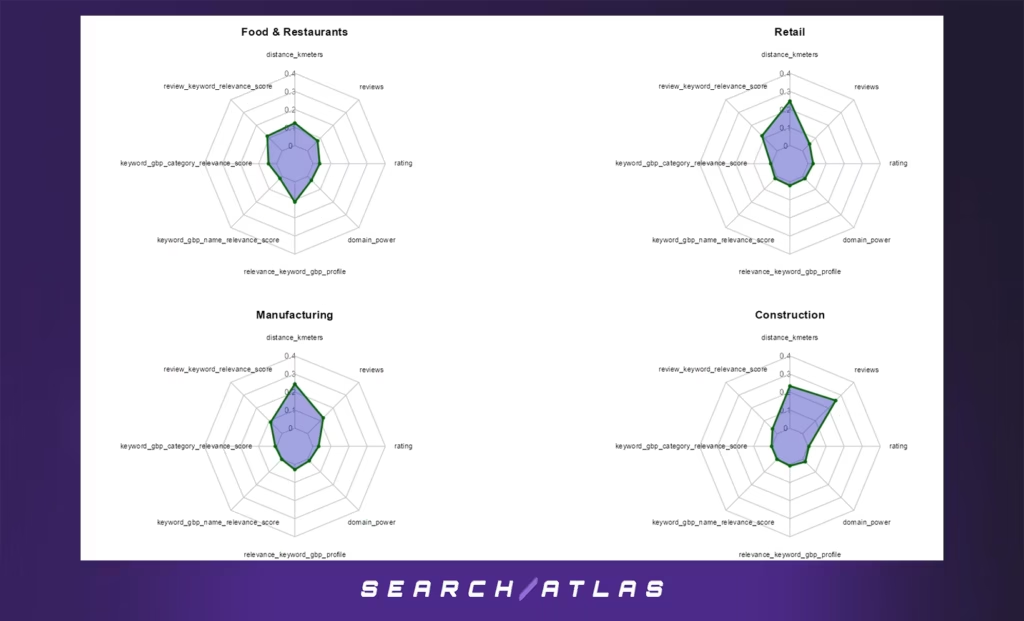
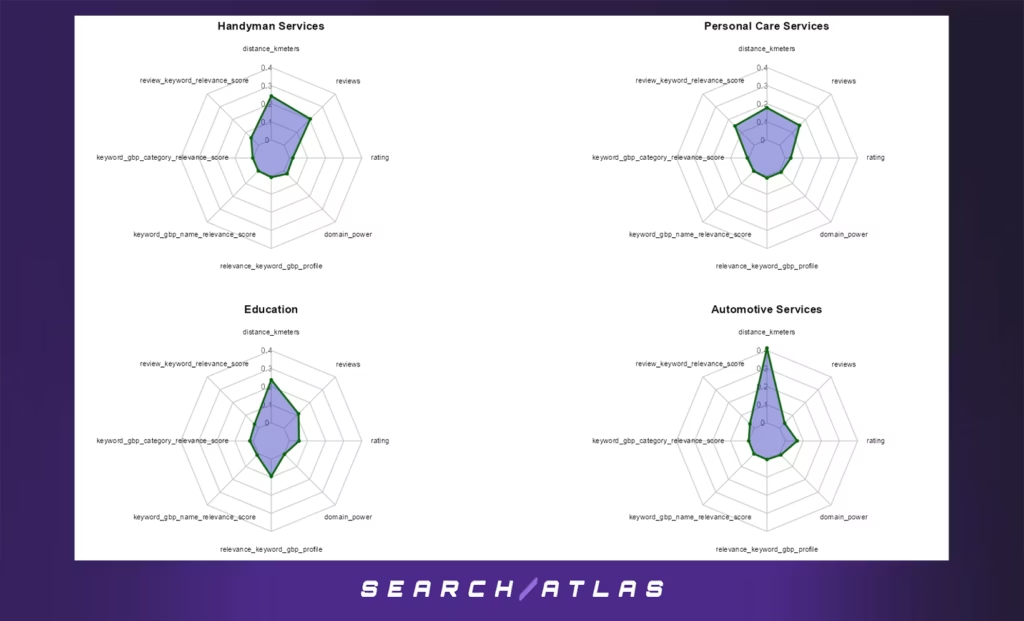
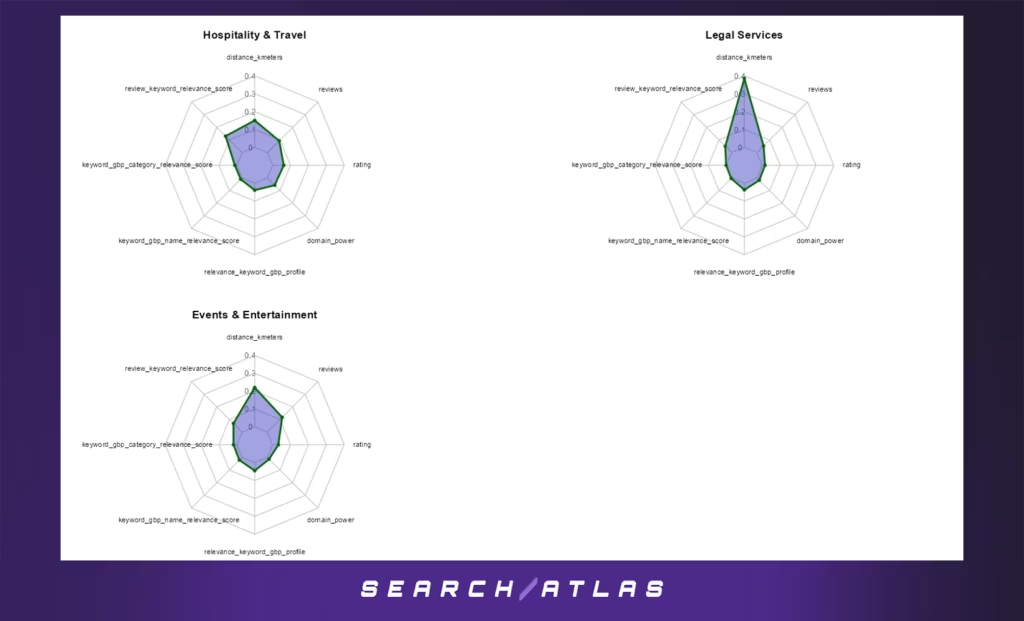
What Should Local Businesses Do?
The implications for businesses are listed below.
1. Focus on Hyperlocal Alignment
For industries where proximity strongly influences rankings, ensure your GBP location accurately reflects your true service area. Position your business as close as possible to the center of customer demand. Businesses serving multiple regions should consider creating distinct, well-optimized listings per location to capture hyperlocal intent effectively.
2. Develop a Keyword-Rich Review Strategy
Encourage satisfied clients to leave detailed, descriptive reviews that naturally include relevant keywords. Use subtle prompts or automated tools (that comply with Google’s policies) to help customers highlight specific services, products, or outcomes. Regularly audit your review corpus to monitor keyword coverage and sentiment trends.
3. Enhance Content Relevance and Semantic Targeting
Craft GBP descriptions, services, and business categories using semantically rich language that reflects user intent. Incorporate related entities and high-intent keywords to help Google’s algorithms understand your niche and match your profile with qualified local searches.
4. Adopt Industry-Specific Optimization Tactics
Different sectors rank on different signals. For instance, link authority may drive visibility in Technology, while proximity and reputation dominate in Retail or Health Services. Customize your local SEO strategy to reflect these sectoral differences instead of applying a one-size-fits-all approach.
5. Leverage Behavioral Data for Continuous Improvement
Monitor user actions from your GBP—such as clicks, calls, direction requests, and dwell time—to understand how customers engage with your listing. Behavioral insights can guide adjustments to photos, descriptions, and call-to-action elements to improve engagement metrics and, over time, rankings.
6. Track SERP Volatility and Temporal Shifts
Ranking dynamics fluctuate due to Google updates and algorithmic changes. Implement ongoing SERP tracking to identify volatility patterns, measure performance over time, and quickly respond to ranking drops or visibility spikes. Longitudinal tracking helps safeguard against disruptions from core or spam updates.
How Does This Compare to Industry Wisdom?
The study supports existing observations from the SEO community that proximity, reviews, and relevance shape rankings. The difference is quantification. The models assign measurable percentages to each factor.
The study extends beyond citations and NAP (Name, Address, Phone) consistency. It incorporates review text relevance, backlink anchor alignment, and URL content matching. These signals show that Google applies natural language processing (NLP) and entity recognition to extract meaning from reviews, website metadata, and backlink anchors.
What Could be the Limitations of the Study?
Every model has boundaries. The limitations of the study are listed below.
- The models only use structured GBP and SEO data. They do not include unstructured information like images, recent user interactions, or behavioral signals, which may affect rankings.
- Centroid approximation. Proximity is based on an estimated centroid and may not match Google’s real-time searcher locations.
- Causal inference. Feature importance shows relationships, not cause-and-effect. Some top features may reflect other hidden factors.
- Industry variability within sectors. Broad industry categories, like Professional Services, hide differences between subgroups such as accountants and consultants.
- Dynamic SERPs. GBP rankings change due to algorithm updates, spam filters, and personalized search, which static models cannot capture.


